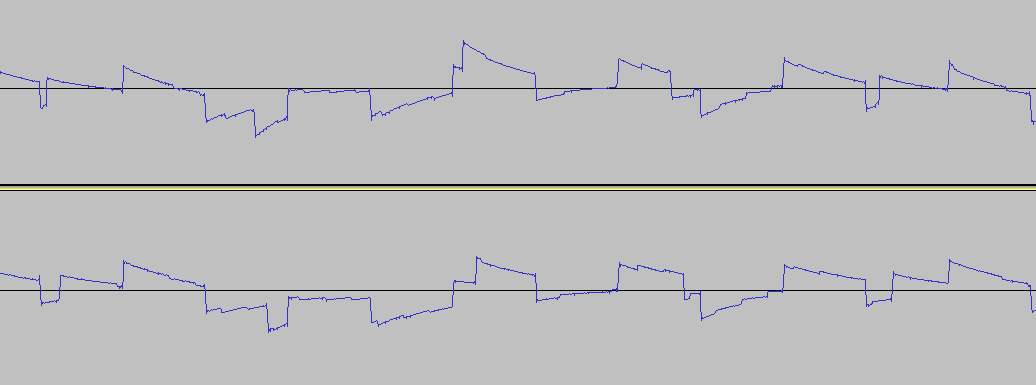I had been always tickled by the fact that sometimes seems to be a "need to" buy a DMG to make chiptune with portable nintendo devices, the only reason given is "it has more bass"
so I made a comparison merely for fun some weeks ago trying to be objetive to find out what's happening with those machines
On the pictures on the top is always the Pocket Game Boy as is, and in the bottom the prosounded Game Boy Color (the ones i have btw)(i have no clue on how prosound affects PGB but boths seems the same machine)
Sawtooth bass on WAV
Both eat the bass harmonics really hard, seems color has a little more width but nothing you can't do with EQ. On a spectrum analysis PGB has more frecuencies around <40hz, might be noise because its under the fundamental
When you draw in the wav channel the output signal is inversed, so i actually drew a ramp /|/| up and the result is a sawthooth |\|\, the ground is on the top of the lsdj wave drawing tool, that doesnt affect the sound as our brain only understand harmonics
Triwave and Sine on WAV
Say Goodbye to bass frecuencies, seems again color has a little more bass frequencies but none to care, on the fun side triangular seems like a pulse and sine as a triangular
Noise
Not the same at all, or may be my the randomness that make my soundcard capture differents samples, anyway both sound the same to me, is clearly obvious that both are precalculated and follow the same algorithms
Mix of PU1-PU2-WAV
Not the same, but I can't tell by ear what's better (despite the pocket hiss noise)
Mix of four channels
Not the same, but I can't tell by ear what's better (despite the pocket hiss noise)
Musical Context
http://culturachip.org/compos/test/imag … pocket.wav
http://culturachip.org/compos/test/imag … -color.wav
A small saturation on the mix, but that is what happen always when your waveforms are pulses. Is possible to reach a clean melodic bass to make the sound clearer. Both are really great machines to classic chiptune sound, with a sharp and precise a tone. ( as i mentioned I'm not sure how the prosound affects the pocket, in the audio example the pocket is obviously noiser).
For a dance with kicks or a d&b, I dint like the ones I've tried
Spectrum
At mentioned on waveforms seems that color had more bass fundamental frecuencies, although not a difference you cant solve (or not solve) with EQ, the spectra is really the same. Color->Blue, Pocket->red
Machine Noise
Pocket has a high fiiii and some fluctuation on the bass frecuencies, the fiiiiii really makes the sound worse if you want to sharpen your ear as a hi-fi listener, on CGB all the noise was also present but totally removed with prosound. Note in this graphs the amplitude scale is zoomed hard.
Conclusions , (1) Both are the same thing?,(2) Excellent ratio signal/noise on GBC , (3) No enough bass harmonics (4) Prosound really works
Personal opinion: For a classic chiptune genre they are really nice. For making great leads are also good machines. To make dance music I wont bet for them. The sounds is very sharp and with a really warm digital tone. I think they are a bit bullied and underrated because its inefficacy to reach basses.
Best bass I've found for the kind of music I do is drawing a mountain like a narrow gauss bell, that gives a tone that doesn't dirty the mix on the pulse range and has a good presence at bass frecuencies. It does look somehow similar to what a electric bass produces near the attack zone.(again is inverted ground in the lsdj draw tool)
http://culturachip.org/compos/test/imag … ontana.wav
Sound tests
http://culturachip.org/compos/test/imagenes/pocket.wav
http://culturachip.org/compos/test/imagenes/color.wav
_________________
Ok, Ok, thats was for fun, although is trying to objective is obviously not a serious analysis because no prosounded pocket, no dmg, no enough measurements on the scientific standards..... but as I did on a bored Sunday weeks ago I thought that might be fun to share here
up the GBColors!!!, and remember electric guitar has no bass and remains the most overrated instrument in the last century ![]()
Last edited by r0lemusic (May 18, 2014 9:34 am)
